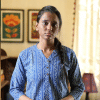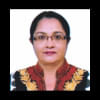Imagining a women-friendly city

While science fiction novels have moved on to imagining lunar cities where people travel on hoverboards, Bangladeshi women can still barely imagine a place where half of its population isn't constantly discriminated against. No one here dreams of hoverboards—they just want good buses they can get on without being groped or having their wallets stolen.
“Our cities—and its infrastructure—were not designed with women and girls in mind. They were not designed by women either. There is a clear lack of understanding of their needs,” said Farah Kabir, the country director of ActionAid. “Whenever there is gender-based violence, the onus is on women, as to why they were at a certain place at a certain time.”
A 2017 poll by the Thomson Reuters Foundation listed Dhaka as the seventh worst megacity for women. Experts in women's issues were asked to rank cities according to the risks women faced—of sexual violence and harassment and harmful cultural practices—and the extent to which they had access to healthcare and economic opportunities.
Dhaka was listed as the third most dangerous city in the world when it came to cultural practices, and the fourth worst in terms of sexual violence faced by women.
Experiences shared by female commuters who either walk or use public transport shed light on the level of discrimination and harassment women suffer on a regular basis.
“Wherever I go, there are boys making inappropriate comments about how I dress. The roads aren't safe after dark. We girls have no freedom,” said Brishti Akhter, a 16-year-old schoolgirl from Ashulia. Her mother is an RMG worker, so Brishti often has to move around by herself during the day.
Nazifa Raidah, a first-year student of Independent University of Bangladesh, who frequently has to commute long distances on a bike, reiterated how difficult it is for single women to navigate the streets of Dhaka.
“There is a preconceived idea here that women aren't supposed to stay out. Female bikers and drivers face incredulity and lack of patience from those on the streets,” she said.
Moving around is notoriously difficult in Bangladesh's traffic-congested cities. “Public transportation isn't female-friendly. Even if I use a ride-sharing app, I'm always alert because I can't fully trust the driver.
I never fall asleep during the ride and constantly share my location with family and close friends,” said Anupoma Joyee, a young barrister working at a law firm in Dhaka, who often returns home late after work.
The answer to women demanding safer public transport has been to create female-only bus services with limited routes. There now exists multiple women-only services on motorbike ride-sharing apps as well.
Most of the efforts that have gone into making the city more women-friendly, focused on making special arrangements that isolate them, rather than making the system inclusive enough to accept them, say urban planners.
“Segregation cannot be the answer, as it may only worsen the situation by marginalising one group. Inclusion is always better,” said Homaira Zaman, an architect and senior lecturer at Bangladesh University.
“Currently just getting into a bus is a horrendous experience. We could easily overcome this issue by designating enough space to make two separate queues. What needs to be addressed is passenger discipline and traffic management,” said Zarina Hossain, an urban planner from Chittagong.
Hossain also suggested that the city undertake a survey to determine the percentage of women travelers and reserve seats accordingly. Currently, buses reserve only nine to 13 seats for women, leaving many with no choice but to stand in the crammed aisle where they are more prone to sexual harassment.
For many women in lower-income groups, such as garment workers and domestic workers, public—or any transport—remains out of reach. They have to find housing close to their area of work or walk long distances every morning and evening.
“I leave my house at 7.15am everyday and walk for over 40 minutes to reach my factory. By the time I enter, I am already too tired and the city streets too are not easy to walk in,” said Rashida Begum, a garment worker living in Tongi.
According to Hossain, pedestrians require wide and smooth walkways, safe and efficient road crossings at around half kilometre intervals, and sufficient trees and shade along major sections. At intervals, there should be small open recesses with trees and a place to sit as well as water fountains and designated spaces for street vendors.
Urban planners also point out that our cities are even less accessible for pregnant women and women with young children. “Pedestrians are forced to climb footbridges to cross the street. Zebra crossings or underpasses would make it easier for everyone—pregnant women, the elderly, and persons with physical disabilities,” said Homaira Zaman.
“We know that mothers often have the responsibility of taking their young children to school. It is common to see a large number of mothers accompanying their children. Many have to linger on footpaths, often all morning under the hot sun, waiting to take them back home safely,” said Hossain.
Lack of public toilets for women and its health ramifications are further shortcomings. “Between when I leave the house in the morning for classes to when I come back home in the evening, I drink as little as possible so that I don't have to use the washroom,” said Sharmin Chowdhury, a student of a public university. The same goes for a female NGO worker who shared that she suffered from a urinary tract infection, as she works for long hours in the field with no usable toilets in sight.
“Half of the city of 20 million is women. Introducing 200 buses and five toilets in the city is not going to do enough,” added Kabir. "The changes that have come after much advocacy and lobbying are more street lights, but these are still inadequate.”
Women in the city need space for leisure and recreation, suggest gender experts and urban planners. They also need to reclaim public spaces.
“It is unfortunate that men feel that the roads and paths and other public spaces belong to them. They are not used to having so many women in public spaces—they do not make way and do not want to share. We have to raise awareness about this,” said Kabir.
“Women need not just protection but also places for recreation. It could be as simple as taking a leisurely walk and spending time alone, or with their children, family and friends. A woman may want to take her children to a playground, but unfortunately these spaces are the most neglected in our cities,” opined Hossain.
Spaces like Ramna Park and the Botanical Gardens were created for public activity, yet these places are left unused, especially by women. “Planners must integrate activities into the design of public spaces,” said Nusrat Sumaiya Tani, coordinator at Bengal Institute for Architecture, Landscapes and Settlements.
She cited the example of Hatirjheel, which was successful in terms of better connectivity but still falls short as an inclusive public space where women can go at any time of the day.
Around the world, recognising that historically cities have been planned by men, for men, local governments are taking measures to make streets feel safer and more secure for women and planning new urban development with women's needs in mind.
Women are still rarely consulted in urban planning in Bangladesh. “There are only a few professionals at the policymaking level who have a voice in urban development projects. This needs to change if we want a city where women feel safe, comfortable and respected,” said Zaman.
However, more women in policy making alone will not ensure an inclusive city if they do not reflect the diverse backgrounds and needs of the city's inhabitants, she added.


 For all latest news, follow The Daily Star's Google News channel.
For all latest news, follow The Daily Star's Google News channel. 








Comments